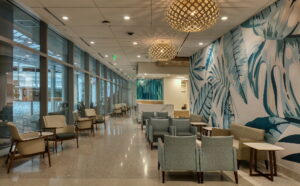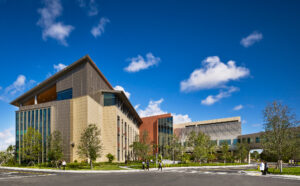By Rolando Conesa
The key to patient experience lies in recognizing that patients are also consumers. This new generation of patients actively goes online to research available options, evaluating convenience, cost and the value they get for their money. They read reviews, assess staff qualifications and look into patient satisfaction surveys and outcomes.
Patients are far more informed about their healthcare choices, and enhancing the patient experience remains critical in the design of healthcare facilities.
A significant aspect of enhancing patient experience is acknowledging this consumer mindset and prioritizing convenience and flexibility to suit their personal needs. In healthcare design, five impactful trends have emerged that showcase the innovative ways in which healthcare spaces are evolving to improve patient experience and promote overall well-being.
1. Welcoming lobbies and waiting rooms

In addition to making an impactful first impression, lobbies, waiting rooms and patient check-in areas can make or break the patient experience. These areas are more than beautiful spaces; they are the embodiment of care, compassion and commitment to well-being. The key to a successful lobby or waiting room is having design solutions that not only make a striking first impression, but also guide patients seamlessly to their next destination with clear, intuitive pathways.
In the past, hospitals used colored tape on floors — for example, blue lines to radiology, green lines to surgery and so on. Now, design-focused intuitive wayfinding supported by thoughtful signage is crucial. The convenience of self-check-in via kiosk or a personal device, or being greeted, directed, quickly registered and guided to the appointment is invaluable in alleviating patient anxiety. Allowing patients to choose their preferable avenue for check-in and check-out allows for flexibility and personalization. For multi-level buildings, patients want to be able to register, attend appointments and leave from the same floor, rather than registering on one floor and then having to navigate multiple levels. From a patient experience perspective, service distribution is highly desirable.

Additionally, a hospitality approach to the interior fit and finish using non-institutional materials that can be easily cleaned, statement lighting, soothing colors and furnishings in smaller groupings, assist in decompression upon arrival and is critical in informing the overall experience for patients. Evidence-Based Design has proven that reduction in patient and caregiver stress improves treatment efficacy. Also proven is the implementation of natural light, biophilic forms, views to greenery and nods to nature throughout the built environment to improve clinical outcomes. From finishes and furnishings to elevated wayfinding, enhancing these spaces through EBD has the power to reduce anxiety and alleviate stress associated with the healthcare experience.
2. Flexible-use spaces
Recognizing that patients’ and facilities’ needs vary from day to day, prioritizing adaptability and versatility through the implementation of flexible-use spaces allows hospitals to meet demands as they arise. Using a kit-of-parts approach, “maker space,” including multi-functional furniture and equipment solutions, space can be reconfigured and reallocated as needed. This can also account for incorporating the family, something that can vary depending on demographics and culture. Family plays a big role in healing and recovery, so sensitivity to these needs is vital.
Personal control can also truly enhance patient experience. The only space patients really have control over as a consumer in a healthcare environment is their personal space, especially if admitted. Increased control in the patient room can include having control over things like temperature, lighting, bed comfort and view. Some patients prefer to be close to nurse stations, while others want to be farther away. These personal preferences matter, and a concierge-style approach can contribute to a greater sense of autonomy. In-room control is not just a luxury; it’s an essential part of improving patient comfort and overall satisfaction.
3. Holistic and wellness-minded campuses
The shift toward treating patients as a whole-being requires a revaluation of facility amenities. The addition of group fitness areas and gyms, family gathering and play areas, meditation and reflection spaces and more promotes a comprehensive approach to physical, mental and spiritual well-being for not only patients, but visitors and healthcare employees, as well.

Access to exterior spaces providing patients, visitors and staff fresh air, sunlight and plantings — whether for eating or reflecting — provide moments of respite and pause away from clinical space. At Baptist Health South Florida Miami Cancer Institute, NELSON Worldwide designed balconies so patients undergoing chemotherapy can still experience being outside. This forward-thinking architectural gesture is frequently used and has made a significant difference in how patients experience their treatment, showing just how impactful these outdoor spaces can be. At the Leon Medical Center – Flagler Center (Fountainbleau, Florida), thoughtfully designed green spaces and lush foliage provide therapeutic benefits, helping to create a calming environment that supports both physical and mental well-being.

Hospitals should also offer a balance of spaces for how much or how little people want to interact with others, whether in waiting rooms, with clinical staff or even with family members. At the Toby & Leon Cooperman Medical Arts Pavilion in Boca Raton, Florida, the nature-inspired design provides a tranquil environment where patients and visitors can recharge. Additionally, versatile spaces were incorporated to adapt to various functions and events, adding an element of flexibility to the building’s layout.
In addition, hospitals have moved toward providing non-denominational “meditation spaces,” providing a variety of religious items such as prayer books, prayer rugs and even harps — inclusive spaces where patients and visitors can practice their faith. Understanding that humans experience the built environment differently drives creativity and inclusivity in design.
4. Elevated food and beverage options
Food service areas in hospitals are becoming more like food halls. Drawing inspiration from the hospitality and fast-casual dining sectors, elevated food and beverage options will enhance the overall patient and visitor experience. Introducing quick-serve counters, specialty coffee stations and a diverse menu right within patient and visitor areas enhances accessibility and convenience, making dining an integral part of the healing process.
Well-designed, strategically placed options not only cater to a wide range of dietary needs with nutritious choices, but also transform dining spaces into communal areas for relaxation and social interaction. Food also connects the facility to the community, and providing locally sourced choices reiterates this connection. Another large part of an elevated food and beverage experience will be the ability for patients to order outside of the scheduled times of breakfast, lunch and dinner.
5. ‘Greening’ of medical office buildings
Incorporating the essence of nature through biophilic design in healthcare settings nurtures a therapeutic atmosphere that cultivates tranquility, diminishes anxiety and enhances the healing process. But, beyond physical appearance, “greening” applies to various other design components.
Ensuring materials are low-VOC, recyclable and aligned with sustainable practices is important to creating a healthier environment. Additionally, the systems behind a building — like air rotation and solutions for isolating infectious areas from non-infectious ones — are crucial, as is subtly segregating those groups through processes and layouts. In general, access to natural light, proper HVAC and lighting, along with materials that support a healthy environment, contribute to a more comfortable and restorative experience for patients.
In today’s evolving healthcare landscape, integrating amenities into facility design is no longer optional — it’s essential for creating patient-centered environments that prioritize convenience, comfort and well-being. By recognizing patients as consumers and tailoring spaces to meet their physical, emotional and social needs, healthcare providers can foster stronger connections, reduce anxiety and enhance overall satisfaction.
From welcoming lobbies and flexible-use spaces, to wellness-minded campuses and elevated food options, each design choice has the potential to transform the patient experience and redefine how care is delivered — one thoughtful, patient-focused detail at a time.
Rolando Conesa, AIA, NCARB, is vice president and healthcare business development leader at NELSON Worldwide.





